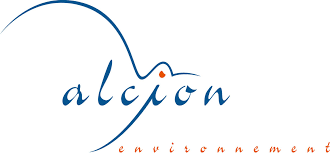Alcion Environnement
Indusrial and territorial ecology

![]() FRANCE
FRANCE
Web: www.alcion-env.com
Contact: contact@alcion-env.com
Location: Bordeaux, France
Sector: End of life
Date of creation: 2001
Analysis by the association: Mars 2018
Maturity of the project: lasting
Valorisation of atmospheric pollutants.
overview
Alcion environnement is an environmental consulting company created in 2001 by Jean-Philippe RICARD, chemical engineer, and Maxime RICARD, engineer ENSAM Bordeaux.
In 2009, they specialize in the management of atmospheric emissions following the development of technical processes for the recovery of NH3 and CO2: VALEAz and VALECARB. Thus, the company assists industrialists and local communities in the recovery of their chemicals. Following numerous trials in Bordeaux wine cellars and industrial development, the first installations were set up at Château Smith Haut Lafitte in 2013.
Since 2016, Alcion Environnement has integrated Veolia Environnement’s SEDE Environnement subsidiary.
- Industrial and territorial ecology
- Recycling
project operation
Alcion environnement offers the following services and products:
1) Diagnosis of the site and processes: study of the industrial site and the production of organic and / or mineral pollutants,
2) Installation of recovery processes: implementation of systems for the recovery of pollutants on the industrial site and exploitation for the account
3) Commercialization of downstream compounds: resale of valued products in new markets on behalf of the customer,
4) Financial and regulatory management of processes and products.
The VALECARB system makes it possible to transform and recover the CO2 resulting from wine fermentation and the production of biogas (digestion). The CO2 is neutralized with sodium carbonate in the form of sodium bicarbonates NaHCO3 and potassium KHCO3.
1000kg CO2 → 3700kg NaHCO3 + 4500kg KHCO3
The sodium bicarbonates NaHCO3 and potassium KHCO3 can then be used in many industries. Wet baking soda is interesting for producers of spirulina, an algae used as a dietary supplement. Dry baking soda is used for the treatment of incineration fumes, but can also be used as bicarbonate food or in cosmetics, food and pharmaceuticals.
The VALEAz system is used to treat ammonia NH3, resulting from sludge treatment, chemical and agro-food industries, composting and methanisation. By stripping¹ and distillation² processes, ammonia supplemented with sulfuric acid or nitric acid is converted into sodium nitrate NaNO3 and in 20% solution of ammonia NH3 in an overall yield of 90%.
Subsequently, the sodium nitrate NaNO3 and the ammonia in NH3 solution are used respectively to treat the sodium sulphide. Hydrogen H2S from wastewater networks and industrial fumes. In addition, they are used for the manufacture of fertilizers and other products of the chemical industry.
Since 2013, a fermentative CO2 capture network has been placed on each tank. On average, for one hectolitre of wine produced, 10 kg of CO2 are released into the vats of vinification. The CO2 is compressed in two reactors and mixed with a solution of sodium carbonate. It is transformed into suspended sodium bicarbonate and then filtered to obtain a moist powder of baking soda.
Thus 10 kg of CO2 allows the production of 36 kg of sodium bicarbonate. A process of drying this powder in rotating drums allows to obtain dry bicarbonate.
Current production of baking soda is about 8 tons per year and should reach about 20 tons in a few years. Currently, part of the bicarbonate soda product is used for the manufacture of cosmetics in the castle hotel, Les Sources de Caudalie, while the majority is sold to French chemical industries. The total cost of the design, development and installation of the prototypes, is about 100 000 €.
In terms of profitability, it would take 12 to 15 years, when the production and sales objectives will be fully achieved (according to the technical director of the estate, Fabien Teitgen). According to the CIVB, the return on investment is rather between 3 and 5 years for investments from 80,000 euros.
sustainable approach
Reduction of the carbon footprint of companies.
While wine-producing activities are a source of CO2, this system is a real carbon sink that captures the emission of fermentative CO2 (greenhouse gases) from winelands and enables growers to use bicarbonate of soda produced locally for the treatment of vines (lack of transport due to the purchase of treatment products). According to the CIVB Climate Plan 2020 roadmap, this system would reduce CO2 production by 10 kg of CO2 per hectolitre of wine produced.
- Lower supply costs when the valued products can be used locally by the company,
- Return on investment between 3 and 5 years for investments from 80,000 euros.
Limits the risk of discomfort and intoxication of agents working in the winery. According to the CIVB Climate Plan 2020 roadmap, this process would allow operators to release 5m3 less CO2 per hectolitre of wine produced.
replicability & future perspectives
Reproducibility is limited to outside of France because of the patent of Alcion environnement on the process. However, the development of facilities at regional and national scales is growing, as new companies want to install this proven system. Through the 2020 climate plan of the Bordeaux wine sector, the CIVB³ encourages winegrowers to implement this process to reduce CO2 emissions.
- Although this system replaces other forms of bicarbonate production from atmospheric waste, it is not a long-term “carbon capture” solution because CO2 is released as the bicarbonate is used.
- Supply not from sustainable sectors: purchase of sodium and potassium carbonates and synthesis of sulfuric and nitric acids. However, a sulfuric and nitric acid recycling project is currently underway.
Glossary
- Stripping¹ = process of extraction of volatile compounds by gas distillation
- Distillation² = process of separation of a mix of liquids whose boiling temperatures are different
- CIVB³ = Conseil Interprofessionnel du Vin de Bordeaux
